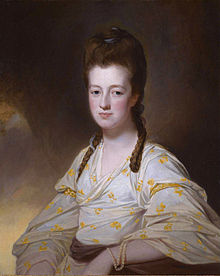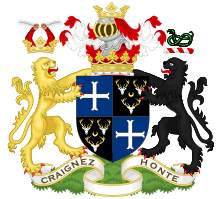William Cavendish-Bentinck, 3rd Duke of Portland
The Duke of Portland | |
|---|---|
 | |
| Prime Minister of the United Kingdom | |
| In office 31 March 1807 – 4 October 1809 | |
| Monarch | George III |
| Preceded by | The Lord Grenville |
| Succeeded by | Spencer Perceval |
| 13th Prime Minister of Great Britain | |
| In office 2 April 1783 – 19 December 1783 | |
| Monarch | George III |
| Preceded by | The Earl of Shelburne |
| Succeeded by | William Pitt the Younger |
| Lord President of the Council | |
| In office 30 July 1801 – 14 January 1805 | |
| Monarch | George III |
| Prime Minister | Henry Addington William Pitt the Younger |
| Preceded by | The Earl of Chatham |
| Succeeded by | Viscount Sidmouth |
| Home Secretary | |
| In office 11 July 1794 – 30 July 1801 | |
| Monarch | George III |
| Preceded by | Henry Dundas |
| Succeeded by | Lord Pelham |
| Personal details | |
| Born | 14 April 1738 Nottinghamshire |
| Died | 30 October 1809 (aged 71) Bulstrode Park, Buckinghamshire |
| Political party | Whig, later Tory |
| Spouse | Lady Dorothy Cavendish |
| Children | 6 |
| Alma mater | Christ Church, Oxford |
| Signature |  |
William Henry Cavendish Cavendish-Bentinck, 3rd Duke of Portland KG PC (14 April 1738 – 30 October 1809) was a British Whig and Tory statesman, Chancellor of the University of Oxford, Prime Minister of Great Britain, serving in 1783 and Prime Minister of the United Kingdom from 1807 to 1809. The 24 years between his two terms as Prime Minister is the longest gap between terms of office of any Prime Minister. He was known before 1762 by the courtesy title Marquess of Titchfield. He held a title of every degree of British nobility—Duke, Marquess, Earl, Viscount, and Baron. He is also a great-great-great-grandfather of Queen Elizabeth II through her maternal grandmother.
Biography
Early life and education
Lord Titchfield was the eldest son of William Bentinck, 2nd Duke of Portland and Margaret Cavendish-Harley and inherited many lands from his mother and his maternal grandmother.[1][2][3] He was educated at Westminster and Christ Church, Oxford.
Marriage and children

On 8 November 1766, Portland married Lady Dorothy Cavendish, a daughter of William Cavendish, 4th Duke of Devonshire and Charlotte Boyle. They were parents of six children:
- William Bentinck, 4th Duke of Portland (24 June 1768 – 27 March 1854).
- Lord William Henry Cavendish-Bentinck (14 September 1774 – 17 June 1839).
- Lady Charlotte Cavendish-Bentinck (3 October 1775 – 28 July 1862). Married Charles Greville, and they had three sons: Charles Cavendish Fulke Greville, Algernon Greville, and Henry William Greville (1801–1872), and a daughter, Harriet (1803-1870) m. Francis Egerton, 1st Earl of Ellesmere.[4]
- Lady Mary Cavendish-Bentinck (13 March 1779 – 6 November 1843).
- Lord Charles Bentinck (3 October 1780 – 28 April 1826). Paternal grandfather of Cecilia Bowes-Lyon, Countess of Strathmore and Kinghorne.
- Lord Frederick Cavendish-Bentinck (2 November 1781 – 11 February 1828) married Lady Mary Lowther (d. 1863), daughter of William Lowther, 1st Earl of Lonsdale, September 16, 1820; had issue: George Cavendish-Bentinck.
Portland is a great-great-great-grandfather of Queen Elizabeth II (see ancestry of Elizabeth II).
Political and public offices
He was elected to sit in the Parliament for Weobley in 1761 before entering the Lords when he succeeded his father as Duke of Portland the next year. Associated with the aristocratic Whig party of Lord Rockingham, Portland served as Lord Chamberlain of the Household in Rockingham's first Government (1765–1766) and then as Lord Lieutenant of Ireland in Rockingham's second ministry (April–August 1782); he resigned from Lord Shelburne's ministry along with other supporters of Charles James Fox following Rockingham's death.[5]
In April 1783, Portland was brought forward as titular head of a coalition government as Prime Minister, whose real leaders were Charles James Fox and Lord North. He served as First Lord of the Treasury in this ministry until its fall in December of the same year. During his tenure the Treaty of Paris was signed formally ending the American Revolutionary War.
In 1789, Portland became one of several vice presidents of London's Foundling Hospital. This charity had become one of the most fashionable of the time, with several notables serving on its board. At its creation, fifty years earlier, Portland's father, William Bentinck, 2nd Duke of Portland, had been one of the founding governors, listed on the charity's royal charter granted by George II. The hospital's mission was to care for the abandoned children in London; and it achieved rapid fame through its poignant mission, its art collection donated from supporting artists, and popular benefit concerts put on by George Frideric Handel. In 1793, Portland took over the presidency of the charity from Lord North.
Along with many such conservative Whigs as Edmund Burke, Portland was deeply uncomfortable with the French Revolution and broke with Fox over this issue, joining Pitt's government as Home Secretary in 1794. He continued to serve in the cabinet until Pitt's death in 1806—from 1801 to 1805 as Lord President of the Council and then as a Minister without Portfolio.
In March 1807, after the collapse of the Ministry of all the Talents, Pitt's supporters returned to power; and Portland was, once again, an acceptable figurehead for a fractious group of ministers that included George Canning, Lord Castlereagh, Lord Hawkesbury, and Spencer Perceval.
Portland's second government saw the United Kingdom's complete isolation on the continent but also the beginning of recovery, with the start of the Peninsular War. In late 1809, with Portland's health poor and the ministry rocked by the scandalous duel between Canning and Castlereagh, Portland resigned, dying shortly thereafter.
He was Recorder of Nottingham until his death in 1809.
Death and burial

The 3rd Duke of Portland died at Bulstrode Park, Buckinghamshire, after an operation to remove a kidney stone on 30 October 1809 and was buried in St Marylebone Parish Church, Marylebone, London.[6]
He had lived expensively: with an income of £17,000 a year (worth £577,000 in 2005),[7] he had debts at his death computed at £52,000 (£1.76 million in 2005),[7] which were paid off by his succeeding son selling off some property including Bulstrode.[8]
Along with Sir Robert Peel, Earl of Aberdeen, Benjamin Disraeli, William Ewart Gladstone, Marquess of Salisbury, Sir Henry Campbell-Bannerman, Andrew Bonar Law, and Neville Chamberlain, he is one of nine British Prime Ministers to die while his direct successor was in office, and the first to do so.
Legacy
The Portland Vase of Roman glass was given its name due to it having been owned by Portland at his family residence at Bulstrode Park.
Portland parish in Jamaica was named after the 3rd Duke of Portland. The Titchfield School, founded in 1786, also in the parish is also named in his honor. The school's crest is derived from the Earl of Portland's personal crest.
North Bentinck Arm and South Bentinck Arm were named for the Bentinck family by George Vancouver in 1793, along with other names on the British Columbia Coast such as Portland Canal and Portland Channel.
The department of Manuscripts and Special Collections, The University of Nottingham holds a number of papers relating to the 3rd Duke: the 3rd Duke's personal and political papers (Pw F) are part of the Portland (Welbeck) Collection; and the Portland (London) Collection (Pl) contains correspondence and official papers of the 3rd Duke, especially in series Pl C.
The Portland Estate Papers held at Nottinghamshire Archives also contain items relating to the 3rd Duke's properties.
The Portland Collection of fine and decorative art includes pieces owned and commissioned by the 3rd Duke, including paintings by George Stubbs.
Titles and arms

Titles from birth
- Marquess of Titchfield (1738–61)
- Marquess of Titchfield MP (1761-1762)
- His Grace The Duke of Portland (1762–65)
- His Grace The Duke of Portland, PC (1765–94)
- His Grace The Duke of Portland, KG, PC (1794–1809)
Arms

|
|
Cabinets as Prime Minister
First Ministry, April – December 1783
- The Duke of Portland — First Lord of the Treasury
- Lord Stormont — Lord President of the Council
- Lord Carlisle — Lord Privy Seal
- Lord North — Secretary of State for the Home Department
- Charles James Fox — Secretary of State for Foreign Affairs
- The Viscount Keppel — First Lord of the Admiralty
- Lord John Cavendish — Chancellor of the Exchequer
- The Viscount Townshend — Master-General of the Ordnance
- Lord Northington — Lord-Lieutenant of Ireland
- The Great Seal is in Commission
Second Ministry, March 1807 – October 1809
- The Duke of Portland — First Lord of the Treasury
- Lord Eldon — Lord Chancellor
- Lord Camden — Lord President of the Council
- Lord Westmorland — Lord Privy Seal
- Lord Hawkesbury, after 1808, Lord Liverpool - Secretary of State for the Home Department
- George Canning — Secretary of State for Foreign Affairs
- Lord Castlereagh — Secretary of State for War and the Colonies
- Lord Mulgrave — First Lord of the Admiralty
- Spencer Perceval — Chancellor of the Exchequer and of the Duchy of Lancaster
- Lord Chatham — Master-General of the Ordnance
- Lord Bathurst — President of the Board of Trade
- Changes
- July 1809 — Lord Harrowby, the President of the Board of Control, and Lord Granville Leveson-Gower, the Secretary at War, enter the Cabinet
References
- ^ "Line of descent of the Earls and Dukes of Portland" (PDF). University of Nottingham. Retrieved 24 March 2015.
- ^ Settlements, mortgages, litigation, Acts of Parliament etc. relating to the 'maternal' estates of the Dukes of Portland; 1583–1790, The University of Nottingham, UK.
- ^ Series of manorial papers in the Newcastle (Clumber) Collection (1st Deposit); 1357–1867, The University of Nottingham, UK.
- ^ "Harriet Catherine Greville".
- ^ Stephens, Henry Morse (1885). . In Stephen, Leslie (ed.). Dictionary of National Biography. Vol. 4. London: Smith, Elder & Co.
- ^ Oxford Dictionary of National Biography, Volume 5. Oxford University Press. 2004. p. 268. ISBN 0-19-861355-5.
- ^ a b [1] National Archives currency converter.
- ^ Oxford Dictionary of National Biography, Volume 5. pp. 268–269.
External links
- William Bentinck, Duke of Portland profile on the 10 Downing Street website
- Biography of the 3rd Duke, with links to online catalogues, from Manuscripts and Special Collections, The University of Nottingham
- Portraits of William Henry Cavendish Bentinck, 3rd Duke of Portland at the National Portrait Gallery, London
- "Archival material relating to William Cavendish-Bentinck, 3rd Duke of Portland". UK National Archives.
Ancestors
Succession boxes
- 1738 births
- 1809 deaths
- People from Nottinghamshire
- People educated at Westminster School, London
- Alumni of Christ Church, Oxford
- 18th-century heads of government
- 19th-century heads of government
- British MPs 1761–68
- British Secretaries of State
- Chancellors of the University of Oxford
- Dukes of Portland
- Bentinck family
- Knights of the Garter
- Lord-Lieutenants of Nottinghamshire
- Lord Presidents of the Council
- Members of the Parliament of Great Britain for English constituencies
- Members of the Privy Council of Great Britain
- Prime Ministers of the United Kingdom
- Fellows of the Royal Society
- Portland, Victoria
- Whig Prime Ministers of the United Kingdom
- Prime Ministers of Great Britain
- British landowners

